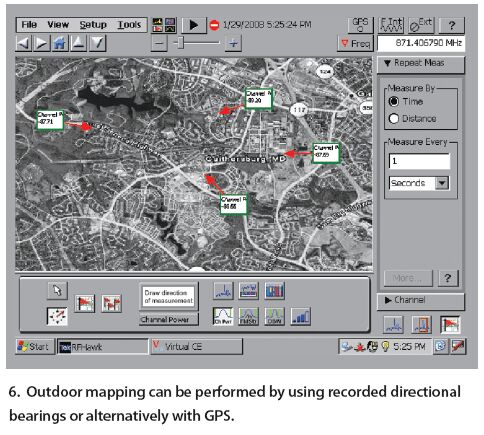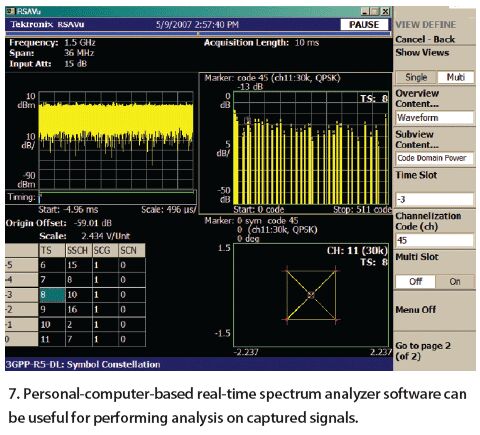With the increasing number of complex digitally modulated signals in wireless systems, on-site identification and analysis of RF signals such as GPS is becoming more challenging, especially in urban environments. However, on-site signal identification and analysis is also very important to improve the design of GPS applications. How to solve this problem with advanced test equipment and solutions?
This article refers to the address: http://
A sensitive spectrum analyzer with a signal strength meter is one of the first tools required for signal search. The intensity meter produces a tone that can be heard by a speaker or earphone, and the tone changes as the signal strength changes. Using such an instrument is a field-proven method that allows the operator to search for signals while looking at the environment rather than the spectrum analyzer display. This tool also allows the operator to correlate the orientation of the antenna with the tone. They can easily listen to the tone while driving or walking, in order to find higher tones. Unfortunately, some signals are hard to find. Conditions such as low signal strength, multipath effects, and other signal distortions require more advanced techniques. In this case, the mapping signal will be very useful to help deal with complex situations.
The first type of mapping involves recording traces or measurements on a map at a location obtained by the operator's current Global Positioning System (GPS). While the signal is being recorded, the operator can draw a vector in red to indicate the orientation of the signal (Figure 6). This approach quickly resolves the complexity of reflections or obstacles. After the data collection is complete, the operator can view the traces and analyze the data on the spot without having to return to the vehicle, office or laboratory. Another form of mapping is the use of a GPS-driven spectrum analyzer to automatically map and record signals as the operator moves. In this case, it can be seen from the icon color when the signal is close to the limit set by the operator. This method quickly finds the signal when it encounters complex RF problems.

The third form of signal mapping is very useful in indoors where GPS cannot work. In this mode, the operator can automatically record signals on the floor plan of the building while walking. This method draws on the technology of the drive tester, but needs to know the start and end points of the walking process and then automatically measure between the start and end points. All of these mapping techniques can be used to collect, analyze and archive data on site.
.
Of course, not every signal can be identified on the spot. New signals, modified signals, signals from damaged devices, and sometimes unknown or anomalous signals exist in every corner of the world. Since the signal modified from the standard is likely to be a suspect in signal search, it is necessary to capture signal samples in the laboratory for further analysis. With enough capture memory, the spectrum analyzer can capture one or more frames of state-of-the-art digital signals. If captured in the correct format, the data can be analyzed offline with tools such as a personal computer (PC) version of a real-time spectrum analyzer (Figure 7), or the analytical tool such as The Mathworks' Matlab software. .

With the development of RF communication systems, new and more efficient technologies are emerging. Many systems use more advanced digital modulation formats, so it is increasingly difficult to screen out suspicious signals from legitimate communication signals. The separation of illegal RF signals from legitimate signals is the first step. Since the signal is constantly changing over time, signal recording is often essential to accomplish this task. Records can be triggered by time intervals or signal template violations. Recording in the spectrogram mode of the spectrum analyzer quickly forms a trace index, so intermittent or weak signals can be detected very quickly.
Once the signal is detected, it can be judged against a series of parameters. Power levels, frequency, channel characteristics, shape, position, and timing are all important parameters. Dynamic behaviors such as bursts or frequency hopping are also important. The SCD measurement method can also be used to view the interior of the signal to better understand the internal rate structure of the signal. This measurement checks the internal data rate of the signal. This parameter is difficult to disguise. If the signal is not normal, this parameter is easily affected.
If all of the above tests for a suspicious signal fail, it is likely to be the right time to locate the signal. A wideband spectrum analyzer with a signal search tool and integrated mapping helps to accomplish this positioning task, regardless of whether the signal search occurs indoors or outdoors. Finally, if the signal is indeed new, it is wise to capture a sample of this signal for future analysis. Saving and classifying unknown signals can help save time in future signal search situations. Off-the-shelf software and numerous development kits can also help with this task.
Sport Camera,Camera Underwater,Sport Dv Gopro
Thefirst International Lighting Co., Ltd. , http://www.gddivinglight.com